| Roman Catholic Church
of St. Anne
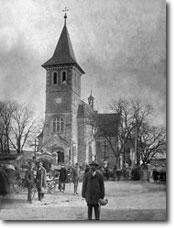 |
|
In former times, the Roman
Catholic Church of St. Anne would have been an impressive
building on the Tluste skyline, rivalling the beauty
of its Greek Catholic counterpart further down the road.
As seen this photo likely taken about 1928, its most
distinguishing feature was a tapered steeple that lent
it a certain charm.
|
| |
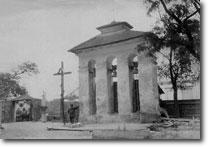 An image probably dating from around 1912 captures the
bell tower ( long since destroyed) that once stood more
or less in front of the main entrance to the church.
An image probably dating from around 1912 captures the
bell tower ( long since destroyed) that once stood more
or less in front of the main entrance to the church. |
Long before then, the church had a rather varied history.
It apparently began its life as one of Tluste’s forts,
dating from around the sixteenth century. Galicia was endowed
with a large number of castle-forts at that time. In fact,
they were in such close proximity to one another that when
danger was imminent neighbours could be alerted by way of
a warning signal. Tluste is said to have played an important
role in this regard, as a protective buffer for the nearby
towns of Czerwonogrod and Jaslowiec, 7 km and 28 km distant,
respectively.
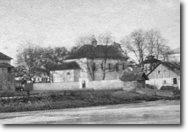 |
|
Roughly rectangular in shape, the fort was rebuilt several
times over the centuries. By the early twentieth century,
the building was already being used as a Roman Catholic
church, although period photos reveal the design to be
much simpler. |
|
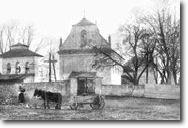
|
|
The ancient gates to Tluste were located
near the ancient fort, but they were ruined by the Russians
during the First World War. |
Evidently, plans were already afoot as early as 1902 to transform
the existing church into a much grander edifice. In May of
that year, architect Teodor Talowski from Krakow made a number
of sketches of his proposed design for the new church (pictured
below). His plan was not chosen, however, and it was left
to Jan Zubrzycki – architect of the Greek Catholic church
– to prepare the design that was ultimately realised.
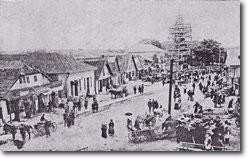 |
|
For the time being, it is not known precisely when reconstruction
began. The photo, opposite, of a streetscene looking
towards the south, reveals the construction nearing
completion, with the new steeple still entirely surrounded
by scaffolding.
|
| The work is known to have
been completed some time before 1915 since the new steeple
appears in another
photo taken around 1914.
Another perspective from across the pond, taken in
1939, is the only photo that captures both the Roman
Catholic and Greek Catholic churches together, in their
prime. |
|
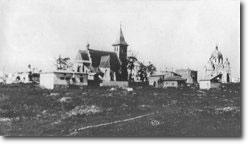 |
In the absence of copies of the original plans for the Roman
Catholic church, one can only deduce the height of its steeple
by comparing it to the known height of the Greek Catholic
church. A comparison of shadows in an aerial photograph, below,
taken May 1944 reveals that the former was only about two
meters shorter than the height of the cupola on the Greek
Catholic church – that is to say, roughly 26 m high.
| |
|
|
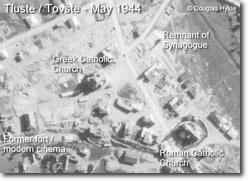 |
|
This photograph is probably one of the
last in existence showing the church steeple intact,
for later that year it was destroyed by the Bolsheviks
under the order of the head of the district.
Before the decade was out, the building had found a
new purpose in life, one that it would retain for decades
to come, after the Russians transformed it into a so-called
‘House of Culture’. |
In the late 1990s, during the course
of work on a gas pipeline, the remnant of a tunnel was
discovered leading from the former fort/church to another
of Tluste’s ancient forts – today a recreation
hall -- located about 225m away.
The tunnel was not excavated, but one can discern part
of it today, as a depression in the earth. |
|
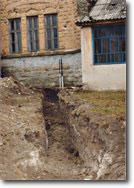 |
The building was reopened as a church around 2000. A religious
icon, in the form of a wooden statue, that had been kept in
the museum for many years after the church’s post-war
destruction, was finally returned to its rightful place. Today,
not only do people of Polish ethnicity go to the weekly mass;
it is said that townspeople of Ukrainian descent also attend
out of interest in order to observe a service that is different
from their own.
Sadly, what remains of the modern Roman Catholic church lacks
the character of its previous incarnation, although attempts
have begun to restore it, beginning with a new roof.
The current restoration project for St. Anne church has been
financed by Poles living abroad with connections to Tovste,
and by local residents. There are plans to rebuild the missing
tower when resources permit. Only then will the original design
of Jan Zubrzycki be returned to its former glory.
If you would like to contribute to the further restoration
of the church, please use the Feedback
page to indicate your potential support.
Source:
Pawlyk, J. History of Tovste. Chortkiv, 2000. and
pers. comm. 
|

